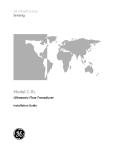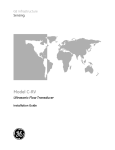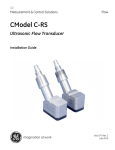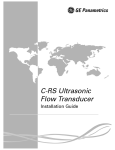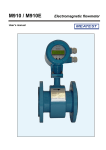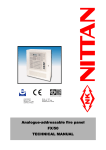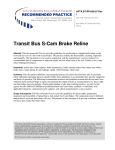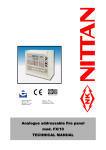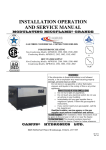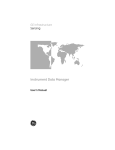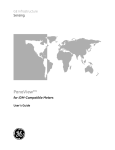Download C-RL Installation Guide 5 MB
Transcript
GE Measurement & Control Flow C-RL Installation Guide 916-062 Rev. B October 2014 C-RL Ultrasonic Flow Transducer Installation Guide 916-062 Rev. B October 2014 www.ge-mcs.com ©2014 General Electric Company. All rights reserved. Technical content subject to change without notice. [no content intended for this page] ii C-RL Ultrasonic Flow Transducer Contents 1. Introduction . . . . . . . . . . . . . . . . . . . . . . . . . . . . . . . . . . . . . . . . . . . . . . . . . . . . . . . . . . . . . . . . . . . . . . . . . . . . . . . . . . 1 2. Transducer Construction . . . . . . . . . . . . . . . . . . . . . . . . . . . . . . . . . . . . . . . . . . . . . . . . . . . . . . . . . . . . . . . . . . . . . . 1 3. Dampening Material . . . . . . . . . . . . . . . . . . . . . . . . . . . . . . . . . . . . . . . . . . . . . . . . . . . . . . . . . . . . . . . . . . . . . . . . . . 2 4. Installing the C-RL Transducers . . . . . . . . . . . . . . . . . . . . . . . . . . . . . . . . . . . . . . . . . . . . . . . . . . . . . . . . . . . . . . . . 3 4.1 Choosing an Installation Location. . . . . . . . . . . . . . . . . . . . . . . . . . . . . . . . . . . . . . . . . . . . . . . . . . . . . . . 5 4.2 Obtaining the Transducer Spacing . . . . . . . . . . . . . . . . . . . . . . . . . . . . . . . . . . . . . . . . . . . . . . . . . . . . . . 6 4.3 Installing the V Series Clamping Fixtures and Transducers . . . . . . . . . . . . . . . . . . . . . . . . . . . . . . . 7 4.3a Setting the Transducer Spacing. . . . . . . . . . . . . . . . . . . . . . . . . . . . . . . . . . . . . . . . . . . . . . . . . . . . . . . . . 8 4.3b Installing the Fixture . . . . . . . . . . . . . . . . . . . . . . . . . . . . . . . . . . . . . . . . . . . . . . . . . . . . . . . . . . . . . . . . . . 10 4.3c Preparing the Pipe . . . . . . . . . . . . . . . . . . . . . . . . . . . . . . . . . . . . . . . . . . . . . . . . . . . . . . . . . . . . . . . . . . . . 13 4.3d Applying the DMP-1 Dampening Material . . . . . . . . . . . . . . . . . . . . . . . . . . . . . . . . . . . . . . . . . . . . . . 15 4.3e Applying DMP-3 Compound . . . . . . . . . . . . . . . . . . . . . . . . . . . . . . . . . . . . . . . . . . . . . . . . . . . . . . . . . . . 17 4.3f Applying the Pipe Dampening Jacket - PDJ . . . . . . . . . . . . . . . . . . . . . . . . . . . . . . . . . . . . . . . . . . . . . 19 4.3g Mounting the Transducers. . . . . . . . . . . . . . . . . . . . . . . . . . . . . . . . . . . . . . . . . . . . . . . . . . . . . . . . . . . . . 21 4.4 Installing the PI Fixture and Transducers . . . . . . . . . . . . . . . . . . . . . . . . . . . . . . . . . . . . . . . . . . . . . . . 24 4.4a Tools and Equipment Needed. . . . . . . . . . . . . . . . . . . . . . . . . . . . . . . . . . . . . . . . . . . . . . . . . . . . . . . . . . 24 4.4b Preparing the Pipe . . . . . . . . . . . . . . . . . . . . . . . . . . . . . . . . . . . . . . . . . . . . . . . . . . . . . . . . . . . . . . . . . . . . 25 4.4c Surveying the Pipe . . . . . . . . . . . . . . . . . . . . . . . . . . . . . . . . . . . . . . . . . . . . . . . . . . . . . . . . . . . . . . . . . . . . 26 4.4d Applying the Pipe Dampening Jacket - PDJ . . . . . . . . . . . . . . . . . . . . . . . . . . . . . . . . . . . . . . . . . . . . . 29 4.4e Installing the First Mounting Block . . . . . . . . . . . . . . . . . . . . . . . . . . . . . . . . . . . . . . . . . . . . . . . . . . . . . 30 4.4f Installing the Second Mounting Block . . . . . . . . . . . . . . . . . . . . . . . . . . . . . . . . . . . . . . . . . . . . . . . . . . . 33 4.4g Mounting the Transducers. . . . . . . . . . . . . . . . . . . . . . . . . . . . . . . . . . . . . . . . . . . . . . . . . . . . . . . . . . . . . 36 4.4h Installing DMP-1 Dampening Material . . . . . . . . . . . . . . . . . . . . . . . . . . . . . . . . . . . . . . . . . . . . . . . . . . 39 4.4i Applying DMP-3 Compound . . . . . . . . . . . . . . . . . . . . . . . . . . . . . . . . . . . . . . . . . . . . . . . . . . . . . . . . . . . . 41 4.5 Maintenance . . . . . . . . . . . . . . . . . . . . . . . . . . . . . . . . . . . . . . . . . . . . . . . . . . . . . . . . . . . . . . . . . . . . . . . . . 42 4.6 Specifications . . . . . . . . . . . . . . . . . . . . . . . . . . . . . . . . . . . . . . . . . . . . . . . . . . . . . . . . . . . . . . . . . . . . . . . . 43 • Special Conditions for Safe Use . . . . . . . . . . . . . . . . . . . . . . . . . . . . . . . . . . . . . . . . . . . . . . . . . . . . . . . . . . . . . . . . 2 • EU / EEA Installation Compliance . . . . . . . . . . . . . . . . . . . . . . . . . . . . . . . . . . . . . . . . . . . . . . . . . . . . . . . . . . . . . . 2 • C-Rx Transducer Assembly Details . . . . . . . . . . . . . . . . . . . . . . . . . . . . . . . . . . . . . . . . . . . . . . . . . . . . . . . . . . . . . 2 • Examples of Markings. . . . . . . . . . . . . . . . . . . . . . . . . . . . . . . . . . . . . . . . . . . . . . . . . . . . . . . . . . . . . . . . . . . . . . . . . 3 Installation Guide iii Contents iv C-RL Ultrasonic Flow Transducer Installation Guide Preface Information Paragraphs Note: These paragraphs provide information that provides a deeper understanding of the situation, but is not essential to the proper completion of the instructions. IMPORTANT: These paragraphs provide information that emphasizes instructions that are essential to proper setup of the equipment. Failure to follow these instructions carefully may cause unreliable performance. This symbol indicates a risk of potential minor personal injury and/or severe damage to the equipment, unless these instructions are followed carefully. CAUTION! WARNING! This symbol indicates a risk of potential serious personal injury, unless these instructions are followed carefully. Safety Issues WARNING! It is the responsibility of the user to make sure all local, county, state and national codes, regulations, rules and laws related to safety and safe operating conditions are met for each installation. WARNING! For installations in potentially hazardous areas, be sure to read the Certification and Safety Statements document at the end of this manual before beginning the installation. Auxiliary Equipment Local Safety Standards The user must make sure that he operates all auxiliary equipment in accordance with local codes, standards, regulations, or laws applicable to safety. Working Area WARNING! Auxiliary equipment may have both manual and automatic modes of operation. As equipment can move suddenly and without warning, do not enter the work cell of this equipment during automatic operation, and do not enter the work envelope of this equipment during manual operation. If you do, serious injury can result. WARNING! Make sure that power to the auxiliary equipment is turned OFF and locked out before you perform maintenance procedures on the equipment. C-RL Installation Guide v Preface Qualification of Personnel Make sure that all personnel have manufacturer-approved training applicable to the auxiliary equipment. Personal Safety Equipment Make sure that operators and maintenance personnel have all safety equipment applicable to the auxiliary equipment. Examples include safety glasses, protective headgear, safety shoes, etc. Unauthorized Operation Make sure that unauthorized personnel cannot gain access to the operation of the equipment. Environmental Compliance Waste Electrical and Electronic Equipment (WEEE) Directive GE Measurement & Control is an active participant in Europe’s Waste Electrical and Electronic Equipment (WEEE) take-back initiative, directive 2012/19/EU. The equipment that you bought has required the extraction and use of natural resources for its production. It may contain hazardous substances that could impact health and the environment. In order to avoid the dissemination of those substances in our environment and to diminish the pressure on the natural resources, we encourage you to use the appropriate take-back systems. Those systems will reuse or recycle most of the materials of your end life equipment in a sound way. The crossed-out wheeled bin symbol invites you to use those systems. If you need more information on the collection, reuse and recycling systems, please contact your local or regional waste administration. Visit http://www.ge-mcs.com/en/about-us/environmental-health-and-safety/1741-weee-req.html for take-back instructions and more information about this initiative. vi C-RL Installation Guide 1. Introduction The C-RL clamp-on ultrasonic flow transducers are used exclusively with the GE Measurement & Control line of ultrasonic flowmeters. These transducers are used to measure the flow of various gases through pipes having diameters from 3/4 in. (20 mm) to 30 in. (750 mm). Such measurements are independent of the pipe material. This document provides details on the following topics: 2. • Transducer Construction • Dampening Material • Installation • Maintenance • Specifications Transducer Construction A transducer assembly includes a 316 stainless housing with a plastic wedge attached and a BNC-type electrical connector. The transducer features integral 3/4” NPT-M threads for mounting a junction box and integral 5/8-24 threads for mounting a submersible connector if desired (see Figure 1 below). BNC Connector 5/8”-24 UNEF Thread 3/4” NPT Thread Spanner Wrench Hole Set Screw SS Housing Plastic Wedge Figure 1: Transducer Assembly (ref dwg 752-163) C-RL Installation Guide 1 3. Dampening Material GE Measurement & Control strongly recommends applying DMP dampening material in all permanent clamp-on applications to help eliminate noise. The following dampening materials are available: • The DMP-1 self-adhesive sheet for applications up to 200°F (93°C). The material comes as two 9.5-in. (24 cm) wide sheets cut in sufficient length for your application. (Length twice the circumference of the pipe at the installation site.) • The DMP-3 is a compound for applications over 150°F (65oC). The compound is applied to the pipe with a putty knife. • Pipe Dampening Jacket (PDJ) is a sheath/jacket with DMP-3 pre-applied to the inside and is also used for applications over 150oF (65oC). The PDJ is available for pipes 4”, 6”, 8”, 10” and 12” (100, 150, 200, 250 and 300 mm) in diameter. At a minimum, you should consider applying dampening material if you have any of the following conditions: • The distance from the nearest butt weld or pipe flange is less than 10 ft (3 m). • The pipe size is under 16 in. (400 mm) diameter and the gas pressure is 200 psig (1,378 kPa) or lower. • The pipe is deformed (non-circular). • The pipe is old, with a history of scaling or rust. • The pipe experiences constant condensation on the outside. Note: Consult a GE flowmeter applications engineer or sales engineer if you have any questions regarding dampening material. Details for properly installing the dampening material are discussed in the installation instructions. 2 C-RL Installation Guide 4. Installing the C-RL Transducers GE Measurement & Control offers the following fixtures to suit your applications needs: • V1 clamping fixture • V4 clamping fixture • V8 clamping fixture • V12 clamping fixture • PI clamping fixture Figures 2 (below) and 3 (on the next page) show the V1, V4, V8, V12 and PI fixture assemblies. Each type of transducer and fixture requires the installation of dampening material for acoustic isolation. Complete the steps in the following sections to position and install the transducers, fixtures and dampening material. Figure 2: The V12 Fixture C-RL Installation Guide 3 4. Installing the C-RL Transducers (cont.) V1 Fixture V8 Fixture V4 Fixture PI Fixture Figure 3: The V1, V4, V8 and PI Fixtures 4 C-RL Installation Guide 4.1 Choosing an Installation Location 1. Locate the transducer measurement point at least 3 ft (1 m) from any butt welds or flanges, ideally in the center of a 20 ft (6 m) length of straight run of pipe. Keep appropriate clearance on either side of the pipe for easy transducer installation: • 6 in. (15 cm) if you are not using a junction box, or • 9 in. (23 cm) if you are using a junction box. Note: To guarantee the specified accuracy of the flowmeter there is no substitute for straight run and fully-developed flow profile. However, if straight run is not available, the transducer location should be in a position such that the acoustic signal travels through the full distribution of the under-developed flow profile for best repeatability. 2. Place the transducers as close as possible to the horizontal plane. Locate the transducers on opposite sides of the pipe 180o apart, ideally at the 3 and 9 o’clock positions. Do not place transducers on the top or bottom of the pipe. Pipe Transducer Signal Path End View C-RL Installation Guide 5 4.2 Obtaining the Transducer Spacing Enter the required information into the flowmeter’s user program (Pipe Parameters menu) to determine the transducer spacing. Some applications may require you to conduct a pipe survey before you can obtain the transducer spacing. Refer to Obtaining the Transducer Spacing section of your User’s Manual or Startup Guide for more details. Proceed to the appropriate section to install the transducers and fixtures: • Installing the V Series Clamping Fixtures on the next page. • Installing the PI Fixture and Transducers on page 24. IMPORTANT: To maintain ATEX certification, the transducer face must be protected against impact. This is provided by properly installing the transducer into the clamping fixture. All care must be provided during installation to ensure all protection is afforded. 6 C-RL Installation Guide 4.3 Installing the V Series Clamping Fixtures and Transducers Installing the V Series clamping fixture and transducers requires the following steps: • Setting the Transducer Spacing • Installing the Fixture • Preparing the Pipe • Applying the Dampening Material • Mounting the Transducers Refer to the following section to properly prepare for installation Tools and Equipment Needed Installing the fixture and transducers requires various tools. You will also need additional tools to apply the dampening material. Refer to Table 1 below for a complete list of everything you will need. Table 1: Tools for V Series Fixture Installation Fixture and Transducers • • • • • • • • straight edge ruler/scale • • thread sealant (for junction boxes only) permanent marker sandpaper file emery cloth ultrasonic thickness gage tape measure dry towel or rag 7/16 in. crescent/box wrench or 4 in. adjustable wrench • 1 in. crescent/box wrench or 10 in. adjustable wrench • other safety equipment suitable for your application DMP-1 • C-RL Installation Guide utility knife DMP-3 • • gloves spatula or putty knife (to remove access dampening compound) PDJ • 7/16 in. crescent/ box wrench or 4 in. adjustable wrench 7 4.3a Setting the Transducer Spacing 1. If necessary, assemble the fixture as shown below. Make sure the zero points on each ruler are at the same end of the fixture as shown below. Insert in 4 places Top View Zero Points 2. Using a ruler (or the ruler printed on the fixture), set one of the mounting blocks at least 1 in. (2.5 cm) from the edge of the fixture. To move the block, loosen the set screw, slide the block to the desired location and tighten the set screw. Use the edge of the block shown below as the setting point. Zero Point on Measuring Scales Set Screw Mounting Block Set at 1 in. (2.5 cm) Set at 1 in. (2.5 cm) using this edge of block Top View 8 C-RL Installation Guide 4.3a Setting the Transducer Spacing (cont.) 3. Slide the other mounting block to the calculated spacing plus 1 in. (2.5 cm). For example: a. Spacing for the first mounting block = 1 in. (2.5 cm) b. Spacing as calculated by the flowmeter = 0.5 in. (12.5 mm) c. Second mounting block final location = 1 in. + 0.5 in. = 1.5 in. (2.5 cm + 1.25 cm = 3.75 cm) The overall spacing between blocks should be left edge to left edge, or right edge to right edge. Note: If possible, the second block should also be set at least 1 in.(2.5 cm) from the edge of the fixture. Set second block using this edge Zero Point on Measuring Scales S C-RL Installation Guide Top View 9 4.3b Installing the Fixture During this procedure you will be required to place the fixture and transducers on the pipe more than once, and in some cases, as many as 3 times. The fixture and transducers are placed on the pipe temporarily for two purposes: • to mark where the fixture and transducers make contact with the pipe so those sections can be cleaned; and, • as a reference for placing the dampening material. Use the steps below to begin installation: 1. Remove any pipe insulation from the installation site. Note: Make sure you clear an area that is large enough for the transducers and dampening material installation. 2. Disassemble the fixture by removing the four nuts from the threaded rods and pulling apart the two halves of the fixture. Note: Make note of the assembled fixture to make sure you reassemble it the same way. Otherwise, the transducer spacing will be incorrect. Remove 4 places Top View 10 C-RL Installation Guide 4.3b Installing the Fixture (cont.) 3. Position the clamping fixture as close as possible to the horizontal plane. The fixture should be positioned so the transducers will be located on the opposite sides of the pipe 180o apart, ideally at the 3 and 9 o’clock positions. Do not place fixture on the pipe so the transducers are the top or bottom of the pipe Note: Make sure you reassemble the fixture properly to ensure the correct transducer spacing. If the fixture has rulers on the rails, make sure the zero points on each ruler are at the same end of the fixture as shown below. Mating Half Top View Zero on Each Measuring Scales Top View C-RL Installation Guide 11 4.3b Installing the Fixture (cont.) 4. Install the four nuts onto the threaded rods with the convex side of the nut facing the fixture. Hand tighten each nut evenly as shown below. DO NOT use a cross-tightening pattern. Nuts (2 places) Nuts (2 places) Top View Tightening Pattern of Bolts Tighten equally first 12 Tighten equally second 2 3 1 4 Side View C-RL Installation Guide 4.3c Preparing the Pipe 1. Using a permanent marker, mark the inside edges of the fixture. These lines indicate where to clean the pipe and then apply the dampening material. Make sure you mark both sides of the fixture. Make marks here and here Top View 2. Remove the fixture. Marks Top View C-RL Installation Guide 13 4.3c Preparing the Pipe (cont.) 3. Clean the area between the marks. Remove any loose paint or rust with sandpaper or emery cloth. Make sure to preserve the original curvature of the pipe. If the finish is mirror-smooth, use the file to roughen the surface. TIP: If you are concerned about removing the reference lines during cleaning, use a tape measure and measure 2 ft (60 cm) from one of the reference lines and mark another line (temporary or permanent). This line can be used as a reference point later. 4. Using an emery cloth, clean the cleared area. Again, take care to preserve the original curvature of the pipe. 5. With an ultrasonic thickness gage, measure the pipe thickness at a minimum of six spots on the cleared area. To ensure accuracy, take at least three measurements at each spot and average the results. The thickness should not vary by more than 5% among the six spots. If you encounter more than a 5% variation among the six spots, move to another section of the pipe. Verify that the wall thickness at both transducer locations has less than the 5% variation. What’s Next? The next series of steps depends on what type of dampening material you are using. If you are using: 14 • DMP-1, proceed to the next section on the next page. • DMP-3, proceed to page 17. • PDJ, proceed to page 19. C-RL Installation Guide 4.3d Applying the DMP-1 Dampening Material 1. Unroll the DMP-1 material and peel back a small part of the paper backing. Do not completely remove the paper backing. One 9.5-in. (24-cm) roll fits between the lines marked on the pipe. 2. Use a dry towel or rag and dry the pipe. IMPORTANT: The dampening material will only adhere to the pipe correctly if the pipe is completely dry. 3. Roll the DMP-1 dampening material around the pipe, peeling the paper backing off as you go. Place the material between the marks that represent the inside edge of the fixture, as shown below. Use the entire length supplied, wrapping the material over itself. 4. Reinstall the fixture making sure the fixture is reassembled correctly to ensure the correct transducer spacing (see Installing the Fixture, beginning with step 3 on page 11). 5. Loosely mount the transducers on top of the dampening material. 6. With a marker, trace around the transducer footprint. Remove the fixture and transducers. C-RL Installation Guide 15 4.3d Applying DMP-1 Dampening Material (cont.) 7. Use a utility knife to cut out the area under the transducer footprint. Peel the cut material off the pipe, as shown below. 8. Reinstall the fixture on the pipe (see Installing the Fixture, beginning with step 3 on page 11). Once the fixture is on the pipe, tighten the four nuts with a 1-in. crescent/box wrench. DO NOT use a cross-tightening pattern. 9. Use the second strip of dampening material for additional dampening. Unroll the second strip of dampening material and cut the strip into two pieces, each 4.5-in. (11 cm) wide. 10. Wrap each of these strips around the pipe on the outside edge of the clamping fixture, one upstream and one downstream. The completed dampening material installation should appear similar to the figure below (with transducers). 11. To mount transducers, refer to Mounting the Transducers on page 21. 16 C-RL Installation Guide 4.3e Applying DMP-3 Compound WARNING! Be sure to wear proper eye and skin protection when applying the dampening compound. Also, make sure there is proper ventilation. 1. Use a dry towel or rag and dry the pipe. IMPORTANT: The dampening material will only adhere to the pipe correctly if the pipe is completely dry. WARNING! High temperature applications! Once the dampening compound is applied to the pipe, the compound may drip and will cause severe burns upon contact with bare skin. Also, be sure not to inhale the fumes generated during the DMP-3 curing cycle. 2. Wearing gloves, place a piece of the DMP-3 material on top of the pipe and use the palm of the hand to press it onto the pipe. Note: If the measurement point is near a flange or weld, apply DMP-3 between that structure and the fixture as well. 3. Spread the DMP-3 material so that it covers the whole area under the fixture to a thickness of about 0.25 in. (6 mm). C-RL Installation Guide 17 4.3e Applying DMP-3 Compound (cont.) 4. Reinstall the fixture around, but not on, the DMP-3 material making sure the fixture is reassembled properly to ensure the correct transducer spacing. (see Installing the Fixture, beginning with step 3 on page 11). Once the fixture is on the pipe, tighten the four nuts with a 1-in. crescent/box wrench. DO NOT use a cross-tightening pattern. 5. Using a putty knife or other utensil, remove the DMP-3 material from the transducer locations. 6. To mount transducers, refer to Mounting the Transducers on page 21. 18 C-RL Installation Guide 4.3f Applying the Pipe Dampening Jacket - PDJ WARNING! Be sure to wear proper eye and skin protection when applying the dampening compound. Also, make sure there is proper ventilation. 1. Remove the backing from the inside of the pipe dampening jacket. WARNING! High temperature applications! Once the dampening compound is applied to the pipe, the compound may drip and will cause severe burns upon contact with bare skin. Also, be sure not to inhale the fumes generated during the DMP-3 curing cycle. 2. Install the jacket on the pipe so the jacket is between the marks and the transducer holes are located at the 3 and 9 o’clock positions. Note: GE recommends placing the PDJ on the pipe so the seam is as close to the of the pipe as possible. Placing the seam at the top of the pipe reduces the amount of dripping. 3. Tighten the clamping screws evenly in sequence (see figure below) taking care not to twist or warp the PDJ. When tightening, some fluid and dampening material will drip from the bottom of the jacket. Note: As the dampening material dries out over several hours after installation, its effectiveness increases. 1 2 3 4 Tighten in sequence C-RL Installation Guide 19 4.3f Applying the Pipe Dampening Jacket - PDJ (cont.) 4. Install the fixture over the jacket (see Installing the Fixture, beginning with step 3 on page 11), adjusting the fixture so the transducer block falls over the pre-stamped transducer holes at the flowmeter spacing calculations. The figure below shows the PDJ and the fixture with transducers. Note: Make sure the fixture is reassembled properly to ensure the correct transducer spacing. 5. Once the fixture is on the pipe, tighten the four nuts with a 1-in. crescent/box wrench. DO NOT use a crosstightening pattern. 6. To mount transducers, refer to Mounting the Transducers on the next page. 20 C-RL Installation Guide 4.3g Mounting the Transducers If your application: • requires junction boxes, refer to step 1 below. • does not require junction boxes, skip to step 3. Note: Dampening material is not shown in the following illustrations. 1. Apply a thread sealant to the transducer threads. A sealant is not required within the U.S., however, a sealant is required for the ATEX certification. 2. Before mounting the transducers, thread the junction box onto the transducer, and make it wrench tight (40 lbf-ft/ 54 N-m). Make sure to orient the cover of the junction box so it is accessible to make cable connections once the box is installed. 3. Apply a bead of couplant 0.25 in. (6 mm) wide along the entire length of each transducer face. The purpose of the couplant is to expel the air gap between the transducer and the pipe. Air will cause the transducer signal to attenuate. IMPORTANT: To prevent the loss of couplant, do not slide the transducer with couplant along the surface of the pipe when mounting. 4. If you are using: • CPL-1, CPL-2 or CPL-3, proceed to the next step. • CPL-16, proceed to step 7 on the next page. C-RL Installation Guide 21 4.3g Mounting the Transducers (cont.) 5. Insert the transducers into the mounting blocks, making sure the BNC connectors (or junction boxes) point away from the center of the fixture. Tighten the pressure bolts to hold the transducers in place. Hand tighten the bolt enough so the transducer makes contact with the pipe. IMPORTANT: Do not use a wrench or pliers on the pressure bolt. Pressure Bolt Transducer Top View 6. Skip to step 10 on the next page. 7. Install the transducers into the mounting blocks, making sure the BNC connectors (or junction boxes) point away from the center of the fixture. Use the pressure bolt to hold the transducer in place while the couplant begins to spread. Wait 1 minute. IMPORTANT: Do not use a wrench or pliers on the pressure bolt. 8. Turn the pressure bolt 1/4 turn and wait 1 minute again. Do not overtighten so that the fixture lifts off the pipe. 9. Repeat step 8 once; then, proceed to the next step. 22 C-RL Installation Guide 4.3g Mounting the Transducers (cont.) 10. For permanent applications, tighten the locking nut with a wrench to maintain constant pressure and prevent loosening due to vibration and thermal expansions. Locking Nut Top View What’s Next? You have completed installing the V Series Clamping Fixture and transducers. You should do all of the following: • Refer to the installation section of your flowmeter User's Manual or Startup Guide to make transducer connections. The cables shall be secured close to the junction boxes so as to prevent twisting and pulling. • Make a note of the installation date and set a schedule for periodic inspection and tightening of clamping fixture nuts to ensure clamping fixture does not become loose and fall, possibly causing injury. • Once the flowmeter is up and running, measure the signal strength of each transducer using the flowmeter’s diagnostics menu and make a note of it. This value will be helpful when making periodic checks. Refer to your User’s Manual or Startup Guide for more details. C-RL Installation Guide 23 4.4 Installing the PI Fixture and Transducers The PI clamping fixture is used for pipes from 6 to 30 in. (150 to 750 mm) in diameter. It consists of two mounting blocks and comes with either a chain (temporary) or strap (permanent), depending on the application. Installing the PI clamping fixture and transducers requires the following: • Preparing the Pipe • Surveying the Pipe • Applying the Dampening Material • Installing the Fixture • Mounting the Transducer Refer to the following section to properly prepare for installation 4.4a Tools and Equipment Needed Installing the fixture and transducers requires various tools. You will also need additional tools to apply the dampening material. Refer to Table 2 below for a complete list of everything you will need. Table 2: Tools for PI Fixture Installation Fixture and Transducers • • sandpaper • • emery cloth • • • • file ultrasonic thickness gage permanent marker thread sealant (for junction boxes only) 7/16 in. crescent/box wrench or 4 in. adjustable wrench other safety equipment suitable for your application DMP-1 • 24 utility knife DMP-3 • gloves • spatula or putty knife (to remove access dampening compound) PDJ • 7/16 in. crescent/ box wrench or 4 in. adjustable wrench C-RL Installation Guide 4.4b Preparing the Pipe 1. Remove any pipe insulation from the installation site. Note: Make sure you clear an area that is large enough for the transducers and dampening material installation. 2. Remove any loose paint or rust with sandpaper or emery cloth. Make sure to preserve the original curvature of the pipe. If the finish is mirror-smooth, use the file to roughen the surface. 3. Using an emery cloth, clean the cleared area. Again, take care to preserve the original curvature of the pipe. 4. With an ultrasonic thickness gage, measure the pipe thickness at a minimum of six spots on the cleared area. To ensure accuracy, take at least three measurements at each spot and average the results. The thickness should not vary by more than 5% among the six spots. If you encounter more than a 5% variation among the six spots, move to another section of the pipe. Verify that the wall thickness at both transducer locations has less than the 5% variation. C-RL Installation Guide 25 4.4c Surveying the Pipe 1. Measure the pipe circumference to an accuracy 1/16 in. ( 2 mm) IMPORTANT: Do not use a calculated value or a nominal value for the circumference. 2. Tightly wrap the layout tape around the entire pipe and line up the edges. Use the whole tape for best results. Using the tape as a template guide, mark a line around the entire circumference of the pipe. Circumferential Line Side View 26 C-RL Installation Guide 4.4c Surveying the Pipe (cont.) 3. Line up the zero scale of the layout tape at the desired transducer location (e.g. 3 or 9 o’clock) of the first transducer. Mark a line (origin line) at least 12 in. (30 cm) long. Zero Point Origin line, min. 12 in. (30 cm) long Side View 4. To find the coinciding point on the opposite side of the pipe (180° away), divide the measured circumference by 2 and measure this distance along the circumferential line from the zero point. Take the 180° point measurement from both over the top of the pipe and under the bottom of the pipe (on a horizontal pipe) to ensure reciprocity of the installation. Mark a small scribe line at the 180o point. 180 deg and C/2 180 deg and C/2 C-RL Installation Guide 27 4.4c Surveying the Pipe (cont.) 5. Mark another origin line at the 180o point at least 12 in. (30 cm) long. 180o Point Origin line, min. 12 in. (30 cm) long Side View (on opposite side of pipe) What’s Next? The next series of steps depends on what type of dampening material you are using: 28 • PDJ, proceed to the next section. • DMP-1 and DMP-3, proceed to Installing the First Mounting Block on page 30. C-RL Installation Guide 4.4d Applying the Pipe Dampening Jacket - PDJ WARNING! Be sure to wear proper eye and skin protection when applying the dampening compound. Also, make sure there is proper ventilation. 1. Remove the backing from the inside of the pipe dampening jacket. WARNING! High temperature applications! Once the dampening compound is applied to the pipe, the compound may drip and will cause severe burns upon contact with bare skin. Also, be sure not to inhale the fumes generated during the DMP-3 curing cycle. 2. Install the jacket on the pipe so the jacket is between the marks and the transducer holes are located at the 3 and 9 o’clock positions. Note: GE recommends placing the PDJ on the pipe so the seam is as close to the of the pipe as possible. Placing the seam at the top of the pipe reduces the amount of dripping 3. Tighten the clamping screws evenly in sequence (see figure below) taking care not to twist or warp the PDJ. When tightening, some fluid and dampening material will drip from the bottom of the jacket. Note: As the dampening material dries out over several hours after installation, its effectiveness increases. 1 2 3 4 Tighten in sequence C-RL Installation Guide 29 4.4e Installing the First Mounting Block Note: The PDJ is not shown in the following illustrations. 1. Loosen the wing nuts up to the end of the J-hooks on both of the mounting blocks. If the mounting blocks have straps no action is required. Loosen Wing Nuts Side View 2. Take one of the mounting blocks and line up one edge of the mounting block so it is centered over the origin line and the front edge of the mounting edge lines up with the circumferential line. Circumferential Line Origin Line Front Edge of Mounting Block 3. Carefully wrap the chain or strap around the pipe, taking care not to twist it. Hook the chain into the J-hook. If you are using a strap, insert the J-hook into the smaller round holes on the strap. Circumferential Line Origin Line Front Edge of Mounting Block 30 C-RL Installation Guide 4.4e Installing the First Mounting Block (cont.) 4. Tighten the chain or strap around the pipe so the mounting block can be moved for adjustments, but not so loose that it will move without being touched. 5. A transducer dummy block is shipped with the PI fixture to ensure the mounting blocks are properly aligned on the pipe. Insert the dummy block into the mounting block so the front edge of the dummy block lines up with the circumferential line as shown below. Origin Line Circumferential Line (outlined in white) 6. Use the pressure bolt to secure the dummy block in place. Hand-tighten enough to hold the dummy block in place. Do not overtighten so that the holder lifts off the pipe. C-RL Installation Guide 31 4.4e Installing the First Mounting Block (cont.) 7. Adjust the mounting block so the indicator line on the dummy block lines up with the origin line on the pipe. Also, make sure the front edge of the mounting block is still lined up with the circumferential line. When the mounting block is properly aligned, tighten the chain or strap to secure it. 32 C-RL Installation Guide 4.4f Installing the Second Mounting Block 1. On the opposite side of the pipe (180o point), mark the transducer spacing point (obtained as described on page 6) on the origin line. Measure from the zero point. Mark the spacing point with a crosshair. Zero Point Chain from First Mounting Block S = Transducer Spacing Point Origin Line Side View (on opposite side of pipe) 2. Using the pipe wrap, make a second circumferential line at the transducer spacing mark around the entire pipe circumference. Chain from First Mounting Block S = Transducer Spacing Origin Line Circumferential Line Side View (on opposite side of pipe) C-RL Installation Guide 33 4.4f Installing the Second Mounting Block (cont.) 3. Line up the other mounting block so it is centered over the origin line and the front edge of the mounting block lines up with the transducer spacing point as shown below. IMPORTANT: Make sure you use the same edge on both blocks. If you do not, the transducer spacing will be incorrect. 4. Carefully wrap the chain or strap around the pipe, taking care not to twist it. Hook the chain into the J-hook. If you are using a strap, insert the J-hook into the smaller round holes on the strap. 5. Tighten the chain or strap around the pipe so the mounting block can be moved for adjustments, but not so loose that it will move without being touched. First Circumferential Line Same (Right) Edge of Block Chain from First Mounting Block Origin Line Transducer Spacing Point Second Circumferential Line Side View (on opposite side of pipe) Spacing (right edge to right edge) Top View 34 C-RL Installation Guide 4.4f Installing the Second Mounting Block (cont.) 6. Remove the transducer dummy block from the first mounting block and install it into the second mounting block. Insert the dummy block into the mounting block so the front edge of the dummy block lines up with the circumferential line as shown below. Origin Line Circumferential Line (outlined in white) 7. Use the pressure bolt to secure the dummy block in place. Hand-tighten enough to hold the dummy block in place. Do not overtighten so that the block lifts off the pipe. 8. Adjust the mounting block so the indicator line on the dummy block lines up with the origin line on the pipe. Also, make sure the front edge of the mounting block is still lined up with the circumferential line. When the mounting block is properly aligned, tighten the chain or strap to secure it. 9. Remove the dummy block from the mounting block. C-RL Installation Guide 35 4.4g Mounting the Transducers If your application: • requires junction boxes, refer to step 1 below. • does not require junction boxes, skip to step 3 below. 1. Apply a thread sealant to the transducer threads. A sealant is not required within the U.S., however, a sealant is required for ATEX certification. 2. Before mounting the transducers, thread the junction box onto the transducer, and make it wrench tight (40 lbf-ft/ 54 N-m). Make sure to orient the cover of the junction box so it is accessible to make cable connections once the box is installed. 3. Apply a bead of couplant 0.25 in. (6 mm) wide along the entire length of each transducer face. The purpose of the couplant is to expel the air gap between the transducer and the pipe. Air will cause the transducer signal to attenuate. IMPORTANT: To prevent the loss of couplant, do not slide the transducer with couplant along the surface of the pipe when mounting. 36 C-RL Installation Guide 4.4g Mounting the Transducers (cont.) 4. If you are using: • CPL-1, CPL-2 or CPL-3, proceed to the next step. • CPL-16, proceed to step 7 below. 5. Insert the transducers into the mounting blocks, making sure the BNC connectors (or junction boxes) point away from the center of the fixture. Tighten the pressure bolts to hold the transducers in place. Hand tighten the pressure bolt enough so the transducer makes contact with the pipe. IMPORTANT: Do not use a wrench or pliers on the pressure bolt. 6. Skip to step 10 on the next page. 7. Install the transducers into the mounting blocks, making sure the BNC connectors (or junction boxes) point away from the center of the fixture. Use the pressure bolt to hold the transducer in place while the couplant begins to spread. Wait 1 minute. IMPORTANT: Do not use a wrench or pliers on the pressure bolt. 8. Turn the pressure bolt 1/4 turn and wait 1 minute again. Do not overtighten so that the fixture lifts off the pipe. 9. Repeat step 8 once; then, proceed to the next step. C-RL Installation Guide 37 4.4g Mounting the Transducers (cont.) 10. For permanent applications, tighten the locking nut (see the figure below for location) with a wrench to maintain constant pressure and prevent loosening due to vibration and thermal expansions. Locking Nut Side View What’s Next? The next series of steps depends on what type of dampening material you are using. If you are using: 38 • PDJ, proceed to What’s Next? on page 41. • DMP-1, proceed to the next section on the following page. • DMP-3, proceed to page 41. C-RL Installation Guide 4.4h Installing DMP-1 Dampening Material 1. Approximate the distance (D) from one transducer to the other transducer as shown below. D 2. Lay out flat the first strip of dampening material. Using a utility knife, cut a strip of a width equal to the distance between transducers (the distance illustrated in the figure above). Peel back a small part of the paper backing. Do not completely remove the paper backing. 3. Use a dry towel or rag and dry the pipe. IMPORTANT: The dampening material will only adhere to the pipe correctly if the pipe is completely dry. 4. Wrap this strip around the pipe in the space between the transducers, peeling the paper backing off as you go. 5. Lay out flat the second strip of dampening material. Then cut the strip into two equal pieces, each 4.5-in. (12-cm) wide. Peel back a small part of the paper backing on each strip. Do not completely remove the paper backing. C-RL Installation Guide 39 4.4h Installing DMP-1 Dampening Material (cont.) 6. Make sure the pipe is dry, then wrap each of these strips around the pipe on the outside edge of each mounting block: one upstream and one downstream. Again, peel the paper backing as you go. The completed installation should appear similar to the figure below (junction boxes not shown). Origin Line Circumferential Line (outlined in white) 7. Refer to What’s Next? on the next page. 40 C-RL Installation Guide 4.4i Applying DMP-3 Compound WARNING! Be sure to wear proper eye and skin protection when applying the dampening compound. Also, make sure there is proper ventilation. 1. Use a dry towel or rag and dry the pipe. IMPORTANT: The dampening material will only adhere to the pipe correctly if the pipe is completely dry. WARNING! High temperature applications! Once the dampening compound is applied to the pipe, the compound may drip and will cause severe burns upon contact with bare skin. Also, be sure not to inhale the fumes generated during the DMP-3 curing cycle. 2. Wearing gloves, place the DMP-3 material in between and on either side of the mounting blocks and transducers. Use the palm of the hand to press it onto the pipe. Note: As the dampening material dries out over several hours after installation, its effectiveness increases. 3. Spread the DMP-3 material so that it covers the whole area around the mounting blocks to a thickness of about 0.25 in. (6 mm). Note: If the measurement point is near a flange or weld, apply DMP-3 between that structure and the fixture as well. What’s Next? You have completed installing the PI Clamping Fixture and transducers. You should do all of the following: • Refer to the installation section of your flowmeter User's Manual or Startup Guide to make transducer connections. The cables shall be secured close to the junction boxes so as to prevent twisting and pulling. • Make a note of the installation date and set a schedule for periodic inspection and tightening of clamping fixture nuts to ensure clamping fixture does not become loose and fall, possibly causing injury. • Once the flowmeter is up and running, measure the signal strength of each transducer using the flowmeter’s diagnostics menu and make a note of it. This value will be helpful when making periodic checks. Refer to your User’s Manual or Startup Guide for more details. C-RL Installation Guide 41 4.5 Maintenance Transducers, couplant, the clamping fixture and dampening material are provided by the factory. Once you have completed installation little maintenance is required. Refer to Table 3 below for maintenance information. 42 Table 3: Maintenance Checks Maintenance Check Component Interval Comments Transducer N/A Couplant Verify every 6 months in dry areas (e.g. the desert). Dampening Material N/A Life of 25 years. Consult factory No cleaning required. for additional information if needed. Clamping Fixture Determined by user. Periodic inspection and tightening of clamping fixture nuts is required to ensure clamping fixture does not become loose and fall, possibly causing injury. No additional adjustments or No cleaning required. maintenance needed. If you suspect something is wrong with a transducer or need to replace a transducer, simply loosen the pressure bolt that secures the transducer in place and remove it. If necessary, loosen the locking nut with a wrench. Refer to the appropriate section to insert a new transducers. Measure the signal strength No cleaning required. using diagnostics and compare to the value taken at the time of installation. Good and bad limits Verify every 12 months are listed in the Service Manual in other areas. or User’s Manual. No cleaning required. C-RL Installation Guide 4.6 Specifications Table 4: C-RL Transducer Specifications Transducer No. Primary Use Installation Type Material of Construction Pipe Sizes Clamping Fixture Operating Frequency 301 Mid-sized pipes, high temperature 302 308 Small pipes, high temperature Mid-size pipes, very high temperature Small pipes, very high temperature >2 to 12” (>50 to 300 mm) 3/4 to 2” (20 to 50 mm) >2 to 12” 3/4 to 2” (>50 to 300 mm) (20 to 50 mm) CFG-V4, CFG-V8, CFG-V12 CFG-V1, CFGV4 CFG-V4, CFGV8, CFG-V12 CFG-V1 500 kHz 1.0 MHz 500 kHz 1.0 MHz Clamp-on 316 SS and plastic Electrical Rating 200 V peak-to-peak, 5 mA Process Temp. Range -40 to 176oC (-40 to 349oF) North American Certification Explosion proof General Purpose European Certification Flameproof General Purpose -40 to 230oC (-40 to 446oF) IP66, TYPE 4X 200Vpp, 5mA North American Certification Weatherproof European Certification Weatherproof 307 IP 66 Note: The transducer is protected by a suitable fuse located in the flowmeter electronics. The fuse has a breaking capacity in accordance with the short circuit current of the supply. C-RL Installation Guide 43 4. Specifications (cont.) Table 5: C-RL Transducer Specifications Transducer No. Primary Use Installation Type Material of Construction Pipe Sizes Clamping Fixture Operating Frequency Electrical Rating 305 Small pipes 304 Low pressure, high velocity; primarily used with TAG technology 306 Low pressure, high velocity; primarily used with TAG technology Clamp on 316 SS and plastic 3/4 to 2” (20 to 50 mm) 6 to 20” (150 to 500 mm) 16 to 30” (400 to 760 mm) Consult factory for larger pipes. CFG-V1, CFG-V4 CFT-V8, CFT-V12, CFT-PI 1.0 MHz 500 kHz 200 kHz 200 V peak-to-peak, 5 mA Ambient Temperature Range North America: -20 to +75°C (-4 to +167°F) Europe: -40 to +75°C (-40 to +167°F) Process Temp. Range -40 to 130oC (-40 to 266oF) — North America and European safe area installations -40 to +75°C — ATEX / European hazardous area installations Class I, Div 1, Group B, C, D North American Certification Explosion proof European Certification Flameproof II 2 G Ex d mb IIC T6 Gb II 2 D Ex mb tb IIIC T80 °C Db. Tamb -40 to 75oC (-40 to 167oF) KEMA 02ATEX2337 X IP66, TYPE 4X 200Vpp, 5mA North American Certification - Weatherproof European Certification Weatherproof IP 66 Note: The transducer is protected by a suitable fuse located in the flowmeter electronics. The fuse has a breaking capacity in accordance with the short circuit current of the supply. 44 C-RL Installation Guide Warranty Warranty Each instrument manufactured by GE Sensing is warranted to be free from defects in material and workmanship. Liability under this warranty is limited to restoring the instrument to normal operation or replacing the instrument, at the sole discretion of GE Sensing. Fuses and batteries are specifically excluded from any liability. This warranty is effective from the date of delivery to the original purchaser. If GE Sensing determines that the equipment was defective, the warranty period is: • one year from delivery for electronic or mechanical failures • one year from delivery for sensor shelf life If GE Sensing determines that the equipment was damaged by misuse, improper installation, the use of unauthorized replacement parts, or operating conditions outside the guidelines specified by GE Sensing, the repairs are not covered under this warranty. The warranties set forth herein are exclusive and are in lieu of all other warranties whether statutory, express or implied (including warranties or merchantability and fitness for a particular purpose, and warranties arising from course of dealing or usage or trade). Return Policy If a GE Sensing instrument malfunctions within the warranty period, the following procedure must be completed: 1. Notify GE Sensing, giving full details of the problem, and provide the model number and serial number of the instrument. If the nature of the problem indicates the need for factory service, GE Sensing will issue a RETURN AUTHORIZATION NUMBER (RAN), and shipping instructions for the return of the instrument to a service center will be provided. 2. If GE Sensing instructs you to send your instrument to a service center, it must be shipped prepaid to the authorized repair station indicated in the shipping instructions. 3. Upon receipt, GE Sensing will evaluate the instrument to determine the cause of the malfunction. Then, one of the following courses of action will then be taken: • If the damage is covered under the terms of the warranty, the instrument will be repaired at no cost to the owner and returned. • If GE Sensing determines that the damage is not covered under the terms of the warranty, or if the warranty has expired, an estimate for the cost of the repairs at standard rates will be provided. Upon receipt of the owner’s approval to proceed, the instrument will be repaired and returned. C-RL Installation Guide 45 Warranty [no content intended for this page] 46 C-RL Installation Guide GE Measurement & Control Certification & Safety Statements Certification & Safety Statements for GE Measurement & Control Clamp-on Ultrasonic Flow Transducer, types C-RL, C-RS & C-RV When installing this apparatus in potentially hazardous areas, the following requirements must be met: • The certification covers the GE clamp-on transducers fitted with an IME 7080 series enclosure (an Ex d & tb approved metal enclosure) and a clamping fixture, the assembly complying with the requirements of EN 60079-1 and EN 6007931, and providing a degree of protection of IP6X. The following standards have been applied: EN60079-0:2009, EN60079-1:2007, EN60079-18: 2009 & EN 60079-31: 2009. • This apparatus is equipment category 2 / EPL Gb & Db and may be installed in zone 1 and 2 areas. It may not be used in a zone 0 area. This apparatus is certified for gas and dust hazards. • The apparatus certification is valid for the ambient and process temperature range combinations listed on the following page. This is not the operational temperature range of the apparatus - check supplied documentation for operational limits. • Field wiring and cable entry fittings shall be rated at least 10° above ambient. Cable entries are 3/4” NPT, see product markings. ATEX approved (Ex d IIC and/or Ex tb IIIC) cable entry devices, appropriately rated, are required. These must be installed according to the manufacturer's instructions. Unused entries must be closed with an approved (Ex d IIC and/or Ex tb IIIC) plug. Connecting cables shall be mounted securely and protected from mechanical damage, pulling and twisting. • The product contains no exposed parts which produce high surface temperatures or infrared, electromagnetic or ionizing radiation. The product must not be subjected to mechanical or thermal stresses in excess of those permitted in the certification documentation and the instruction manual. The metal part of the transducer body and the enclosure shall not be insulated. • There are no internal sources of ignition in normal operation. • The product is a hazardous area electrical apparatus and must be installed in accordance with the requirements of the product certification. The installation must be carried out in accordance with all the appropriate international, national and local regulations, codes of practice and site requirements for hazardous area apparatus and in accordance with the instructions contained in the manual. The installation shall comply with IEC / EN 60079-14. • To avoid an ignition hazard, protect the transducer from impact or friction. In particular, the transducer must be installed so that the face of the transducer is towards the process, protecting the face from impact. • The apparatus must be securely attached to the site of the flow measurement. The transducer assembly must be attached to the pipe as detailed in the user manual. For horizontal pipe runs, the transducers shall be mounted in the horizontal plane. The transducer shall not be mounted on top of the pipe. All NPT joints shall be made up wrench tight, suggested minimum torque is 40 lbf-ft / 54 N.m. Before installation, check that the transducer and enclosure are firmly locked together. Measures must be taken to ensure a good electrical contact and to prevent the threads from selfloosening. An inspection of the joint should be added to the routine maintenance schedule. • To avoid electrical shock, the transducer must be mounted to a metal, electrically grounded, pipe system. • A cable lug shall be used for all connections to the enclosure's earth points. • Each enclosure cover is fitted with a locking device. This device must be loosened before opening the cover. It must be tightened after the cover is replaced so as to preserve the protection provided by the enclosure. Access to the circuitry must not be made during operation; the apparatus should be de-energized before opening. Modifications to the flameproof enclosure are not permitted. 1100 Technology Park Drive, Billerica, MA 01821, U.S.A. Telephone: 978-437-1000 or 800-833-9438 Sensing House, Shannon Free Zone East, Shannon, County Clare, Ireland Telephone: +353 61 470200 CSS-0014, Rev. A July 2014 Certification & Safety Statements for Clamp-on Ultrasonic Flow Transducer, types C-RL, C-RS & C-RV July 2014 • Only trained, competent personnel may install, operate and maintain the equipment. The product cannot be repaired by the user; it must be replaced by an equivalent certified product. Repairs should only be carried out by the manufacturer or by an approved repairer. Special Conditions for Safe Use • To avoid an ignition hazard, protect the transducer from impact or friction. In particular, the transducer must be installed so that the face of the transducer is towards the process, protecting the face from impact. • The transducer must be protected by limiting the maximum fault current. This is achieved by operating the apparatus in conjunction with the following meters: XMT868(i), DF868, AT868, CG868 or CTF878. Only these meters are permitted under the certificate detailed below. • The prospective short circuit current (PSCC) will not exceed 20mA. No power is dissipated internally when there is a short circuit. • The connecting cable shall be secured close to the enclosure to prevent loosening and twisting. • The mounting hardware shall not contain more than 7.5% Magnesium, Titanium or Zirconium. • The assembly shall not be insulated beyond the plastic-to-metal joint on the transducer body. The assembly shall not be mounted on the top surface of a pipe or duct. EU / EEA Installation Compliance The use of this apparatus is subject to the EU directive on minimum requirements for improving the safety and health protection of workers potentially at risk from explosive atmospheres, Council Directive 1999/92/EC. The installer is required to be familiar with this document or the National transposing legislation. C-Rx Transducer Assembly Details Manufacturer and certificate owner: GE Infrastructure Sensing Inc., Billerica, MA 01821, USA. Alternative manufacturing site: GE Sensing EMEA, Shannon, Co. Clare, Ireland QAN License Number: 0794 (USA) or 0795 (Ireland) Notified Body for Quality Assurance: SGS Baseefa Notified Body Number: 1180 Certificate Number: KEMA 02ATEX2337 X Apparatus Markings (see example below): II 2 G Ex d mb IIC T6 Gb II 2 D Ex mb tb IIIC T80°C Db Ambient temperature range (ATEX) -40°C to +75°C Pipe surface temperature range (ATEX) -40°C to +75°C The manufacturing date is encoded in the transducer's serial number; The serial number format is MMYYNNNN - MMYY is month and year of construction + NNNN is a sequential number. CSS-0014, Rev. A 2 of 4 Certification & Safety Statements for Clamp-on Ultrasonic Flow Transducer, types C-RL, C-RS & C-RV July 2014 Examples of Markings CSS-0014, Rev. A 3 of 4 Certification & Safety Statements for Clamp-on Ultrasonic Flow Transducer, types C-RL, C-RS & C-RV CSS-0014, Rev. A July 2014 4 of 4 GE Sensing DECLARATION OF CONFORMITY DOC-0029, Rev. C GE Sensing 1100 Technology Park Drive Billerica, MA 01821 USA We, declare under our sole responsibility that the C-RL, C-RS & C-RV Clamp-on Ultrasonic Flow Transducers to which this declaration relates, are in conformity with the following standards: • EN 60079-0 : 2009 • EN 60079-1 : 2007 • EN 60079-18:2009 • EN 60079-31:2009 II 2 G Ex d mb IIC T6 Gb II 2 D Ex mb tb IIIC T80°C Db KEMA 02ATEX2337X Iss 2 DEKRA Certification BV, Meander 1051, 6825 MJ, Arnhem, NL - NoBo # 0344 • EN 61326-1:2006, Class A, Table 2, Industrial Locations • EN 61326-2-3: 2006 • EN 61010-1:2010, Over voltage Category II, Pollution Degree 2 following the provisions of Directives 2004/108/EC EMC, 2006/95/EC Low Voltage and 94/9/EC ATEX. The units listed above and any ancillary equipment supplied with them do not bear CE marking for the Pressure Equipment Directive, as they attach to the outside of the pipe and are not exposed to the process pressure. . Shannon - June 2014 Issued Niall Ross, Certifications Engineer Customer Support Centers U.S.A. The Boston Center 1100 Technology Park Drive Billerica, MA 01821 U.S.A. Tel: 800 833 9438 (toll-free) 978 437 1000 E-mail: [email protected] Ireland Sensing House Shannon Free Zone East Shannon, County Clare Ireland Tel: +353 (0)61 470200 E-mail: [email protected] An ISO 9001:2008 Certified Company www.ge-mcs.com/en/about_us/quality.html www.ge-mcs.com ©2014 General Electric Company. All rights reserved. Technical content subject to change without notice. 916-062 Rev. B






























































